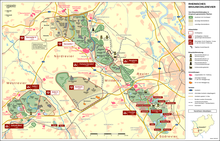Wages (Eschweiler)
Lohn was a district of Eschweiler and, like this, emerged from a Carolingian royal estate . Until the incorporation in 1972, the address with postcode 5181 was "Lohn (via Eschweiler)".
Erberich , Fronhoven , Langendorf , Lohn, Pützlohn and the Hausen manor belonged to the community of Lohn and the parish of the parish of Lohn . They came to the city of Eschweiler in the Aachen district on January 1, 1972 from the Jülich district , around the time when these places were relocated to the western half of Fronhoven and demolished because of the open-cast brown coal mine. The term “parish wage” is still present in the population, so the local carnival association is called “KG parish wage”. From 1962 to 1983 the roughly 690 inhabitants were resettled, primarily to Neu-Lohn to the west . Then the previous place was demolished. For church history see here .
archeology
Before the charring, a number of archaeological sites were excavated in the area around Lohn. This includes numerous longhouses made of ribbon ceramics . The first larger Latène period settlement with multi-house farms and pottery, iron consumer goods and weapons was found near Lohn in Germany . A large late antique burial ground also belonged to a Roman villa rustica .
Presumption of origin
On July 25, 973, Emperor Otto II. Zu Aachen confirmed to Archbishop Gero of Cologne the wild ban given by King Ludwig IV. In the Bürge, in the Kottenforst and in the Ville, stating the boundaries that were already given to the Archbishop and his predecessors by Emperor Otto I. was confirmed: […] hoc est Pesche et M [eribu] ra absque Gerberhteslon, quod [o] pus nostrum accesserit. Is “Gerberhteslon” a wage? Lohn is mentioned with certainty in 1226 as Lon in Rurgau, to which Eschweiler also belonged.
Memorial chapel parish of Lohn
The “Gedächtniskapelle Parish Lohn” was built in 2002 and 2003 to commemorate the five excavated villages of the parish with their two churches, St. Silvester in Lohn and St. Josef in Fronhoven. The chapel stands exactly where the church of Lohn, the "Cathedral of the Jülich Land", once stood. In the immediate vicinity is a lookout point of the Inden opencast mine above the new bed of the Inde .
A barricade divides the interior of the chapel in a ratio of 1: 3. The front part is intended for the visitors and prayers passing by. In front of the bars is a kneeling bench, which like the other benches come from the old church in Lohn. The altar of the chapel, the perpetual chandelier on the right and the sacristy bell on the left come from the Lohner Church. The altar is the former right side altar, the cross between the windows is a cross of the high altar of the Lohner Church. The statue of the Virgin Mary was newly created by a Tyrolean carver and consecrated on May 7, 2004 during a May service.
The idea to build the chapel goes back to Peter Lentzen and Josef Dickmeis. In November 1982, when they were standing in front of the ruins of their home village Lohn, the idea arose to erect a memorial after the reclamation where the old parish church had stood. In 1991 the “Friends of the Memorial Chapel Parish Lohn” was founded. The groundbreaking ceremony took place on November 12, 2001 and the foundation stone was laid on June 29, 2002 - exactly 100 years after the foundation stone was laid for the old parish church. The solemn consecration took place on May 25, 2003.
Individual evidence
- ^ Federal Statistical Office (ed.): Historical municipality directory for the Federal Republic of Germany. Name, border and key number changes in municipalities, counties and administrative districts from May 27, 1970 to December 31, 1982 . W. Kohlhammer, Stuttgart / Mainz 1983, ISBN 3-17-003263-1 , p. 305 .
literature
- Christine Krahn: The ceramic band settlements in the upper Schlangengrabental. Rhenish excavations 57, Mainz 2006.
- Friederike Orendi: Settlement landscape and village genesis in the parish of Lohn (district of Aachen) . Bonn, Habelt, 2014. ISBN 978-3-7749-3886-1 ( University research on prehistoric archeology, 252 ) Zugl .: Munich, Univ., Diss., 2013
- Udo Recker : The medieval parish of Lohn. Contributions to the archeology of rural areas. The main town of Lohn. Bonn 1999. online summary
Web links
- Gedächtniskapelle parish wages on gedaechtniskapelle-lohn.de
- Dissertation on the parish of Lohn on uni-bonn.de
Coordinates: 50 ° 52 ′ N , 6 ° 19 ′ E


